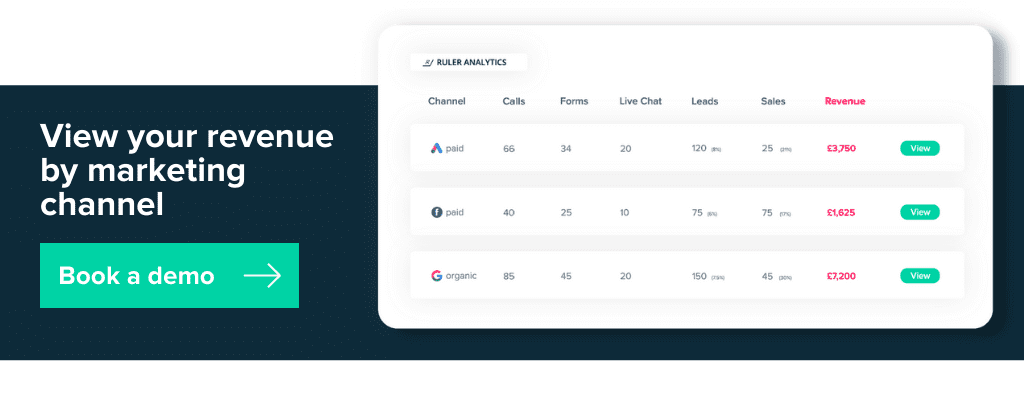Marketers that effectively track lead source can make informed decisions to drive more sales and are able to report an accurate marketing ROI to senior leaders and clients.
Do you know where your leads are coming from?
Not just form submissions and eBook downloads, we’re talking high-quality leads that convert into opportunities through sales qualification.
If the answer is no, you’re not alone.
Leads will often use several traffic sources to track down information, services and products.
In fact, 73% of all customers will use multiple channels during their purchase journey.
As a result, many marketers are finding the process of capturing lead source across multiple touchpoints more and more of a challenge.
To help you overcome this common obstacle, we reached out to 30+ sales and marketing experts across various industries.
We asked them to share their top recommendations, advice and solutions for lead source tracking and put it all together in this handy, easy-to-read guide.
For this article, we’ll discuss:
🚀 Pro Tip
Are you struggling to generate qualified leads for your business? Get the complete guide on lead tracking and gain a single view of your lead generation activity, from the initial awareness to the point of acquisition.
Complete guide to lead generation and tracking
Lead source allows you to track where your leads and opportunities are coming from.
It’s the channel through which a user interacts with before converting into a lead and is essentially the first marketing touchpoint in your sales process.
For example, a user could type in a search term in Google, land on your website and buy a product. In this scenario, organic search would be your lead source.
Tracking lead source is essential as it allows you to better measure, plan and optimise your marketing efforts to generate more solid results for your business.
Let’s take a look at an example to demonstrate the importance of lead source tracking. Below is a table that represents two campaigns, one for Facebook and another for Google Paid.
The objective of both campaigns is to generate more qualified leads in the hope that they’ll convert into revenue.
To measure the performance, you rely on Google Analytics to monitor your conversions and discover that both channels generated 50 leads each.
| Marketing channel | Leads |
| 50 | |
| Google Ads | 50 |
You might say that these campaigns were a success?
Well, before we jump to any conclusions, let’s take a look at the same campaigns, but from a revenue perspective.
Facebook generated 50 leads, but only managed to convert £3,000 in sales, whereas Google Paid generated a whooping £50,000 in revenue.
| Marketing channel | Leads | Revenue |
| 50 | £3,000 | |
| Google Ads | 50 | £50,000 |
Based on that insight, what campaign would you say was most successful now?
Google Paid (we hope).
For a long time, the best solution marketers had for tracking lead source was Google Analytics and with good reason.
Google Analytics is great at telling you how and where your visitors are coming from, but it isn’t perfect.
Related: What are the limitations of Google Analytics?
While Google Analytics gives you a general overview of your lead sources, it doesn’t provide any insight into the quality of your conversions and whether or not they’re closing into revenue.
In addition to this, by default, Google Analytics uses non-direct last-click attribution. With last-click attribution, you can pinpoint the exact lead source that led to a particular conversion.
But, unless you offer emergency services such as healthcare, it’s likely your leads have multiple touchpoints with your brand before reaching out.
Without visibility across all lead sources, you lack insight into which touchpoints make up the most valuable leads and customers.
🚀 Pro Tip
Learn even more about lead tracking with our cheatsheet. You can see how to understand lead source and link conversions to full customer journeys.
“A business uses an average of eight different channels to connect, engage, and convert leads. While all marketing channels can produce leads, their ability to generate the right kind of leads for your organisation is highly dependent on your business type, product, and buyer profile,” says Eric Rohrback, CMO at Hill & Ponton.
There are various types of lead sources. Here are some common examples:
🚀 Pro Tip
We sampled the Ruler Analytics global database across fourteen industries to measure the impact of different marketing channels on traffic and conversions.
Discover which marketing channels drive the most traffic and qualified leads for your industry and track how well you’re doing against the competition.
Download the conversion rate benchmark report
When asked what they thought was the best source of leads, our respondents ranked “organic search (42%)”, “paid search (15.6%)”, and “paid social (14%)” as the top three.
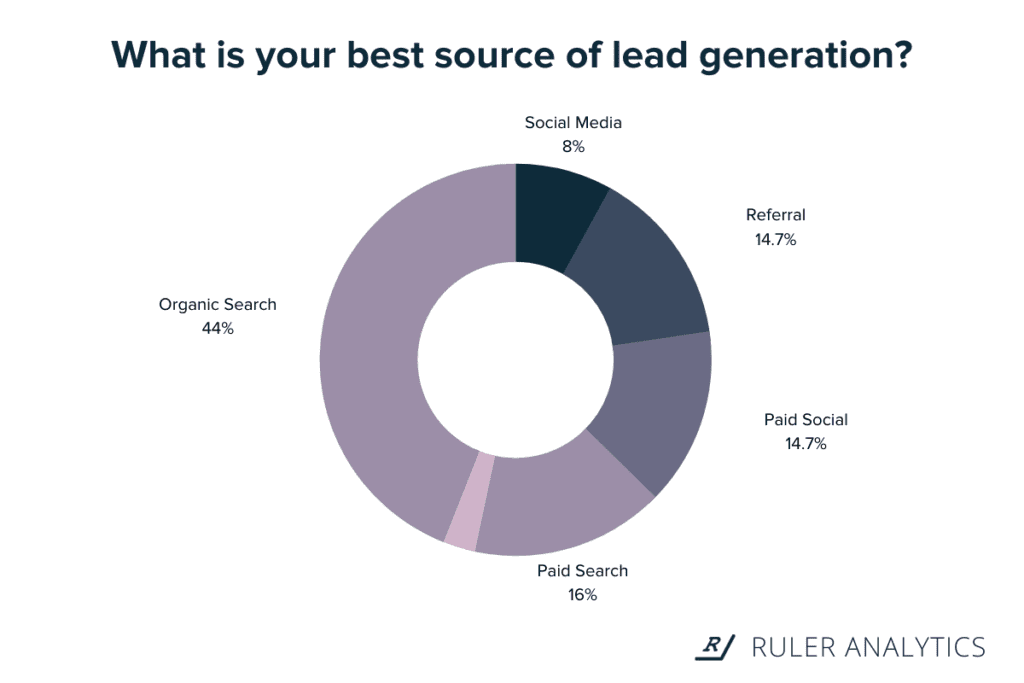
Nearly half of the people we surveyed agreed that organic search was the most valuable source of leads and traffic.
Who can blame them, right?
There is a long list of benefits that come from utilising organic search. For one, organic search allows you to target keywords that bring in highly qualified prospects who are ready to take the next step in their customer journey.
Jason McMahon, Digital Strategist at Bambrick, agrees: “Organic traffic is important for bringing new and qualified users to your website by matching the content on your site to what they’re looking for”.
Let’s not forget that organic search is the most sustainable way to drive traffic and leads.
While it often takes time to conquer the first page of Google, once you get there, the results are long-lasting and significant for your business if done right.
After organic search, we have paid search.
Unlike organic search, pay-per-click advertising allows you to show up immediately for your desired keywords and connect with users who are more likely interested in what you have to offer.
Paid social is another great way to build your brand and lead potential customers to your products and services.
“Defining lead sources is not necessarily as easy as it sounds. Tracking lead sources can get confusing, especially when leads encounter multiple touchpoints,” says Marcus Clarke, Founder at Searchant.co.
Lead source tracking can be overwhelming at first.
With users coming from so many different directions, it can be hard to differentiate between the sources that present real opportunities and those that pose potential risks.
However, with the right tools and processes in place, it can be easy to track where your leads come from and identify the marketing tactics that are delivering the best results for your business.
🚀 Pro Tip
Want to connect revenue with your marketing sources? Closed-loop marketing allows you to pinpoint the lead sources that drive the most (and the least) revenue.
Download the closed-loop marketing attribution guide
To help you get started, we asked experts in the sales and marketing field to weigh in and share top tips on lead source tracking.
Here’s what they had to say:
To successfully track lead source, you’ll need to invest in a solution that can provide intelligence into where and when your marketing efforts influenced a lead.
Advanced lead tracking tools allow you to understand which marketing tactics are driving the most quality traffic and provide insights to convert more of your leads into revenue.
“Lead tracking and marketing attribution software operates on your website to track a lead conversion like a call and form submission. Using distinctive code, it can recognise the source where the lead started, such as online directories, social media sites, paid search ads, organic search results, and more,” says Daniel Foley, CMO at Scooter Guide.

Picking a lead tracking tool for your business can leave you feeling overwhelmed.
There are just so many great options out there already, and it’s a tall task to know what’s right for you.
To help set you off in the right direction, we asked our experts to share a few of their favourite solutions.
“Ruler is the backbone behind the digital marketing campaigns we run for our B2B and lead-gen clients. It allows us to fully understand how our channels are performing, and make data-driven decisions on where our client’s budget can deliver the greatest impact,” says David Berry, Head of Performance & Analytics at Clicky.
Related: How Clicky use Ruler to prove their value to clients
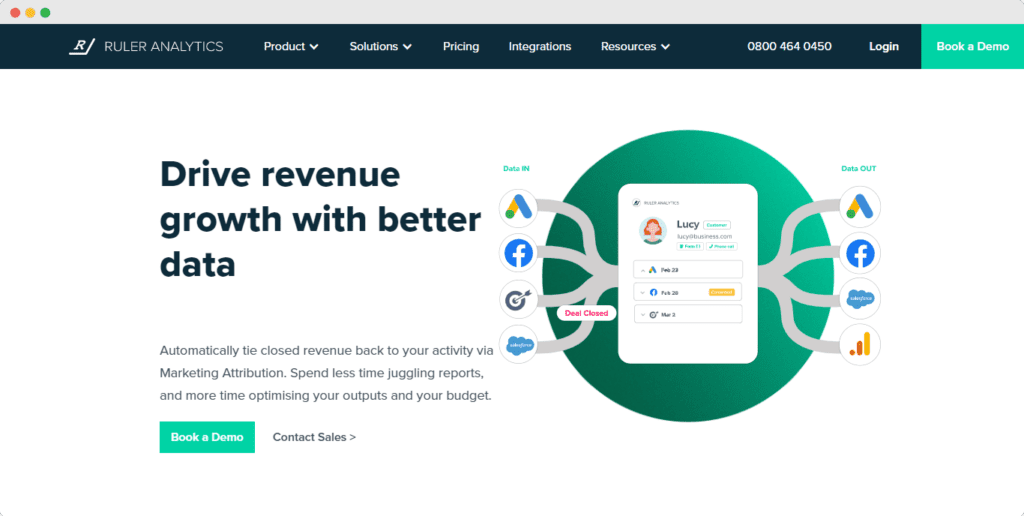
Ruler Analytics is a visitor level multi-touch marketing attribution product for forms, phone calls and live chat.
By automatically integrating with your CRM, analytics and other products, Ruler evidences every step a visitor makes in their journey and automatically matches revenue back to the original lead source.
🚀 Pro Tip
Want to learn more about Ruler but not ready to book a demo? This guide explains what Ruler Analytics does and how it can help boost the quality of your reports with marketing source data.
“Hubspot is a robust platform. Its dashboard allows you to track emails, sales calls, and meetings while giving you insight into trends across the board. Also, it’s helpful to manage and follow up with leads from the dashboard,” says Vincent D’Eletto, Founder and CEO at WordAgents.
Related: HubSpot Attribution: A complete guide and an alternative solution
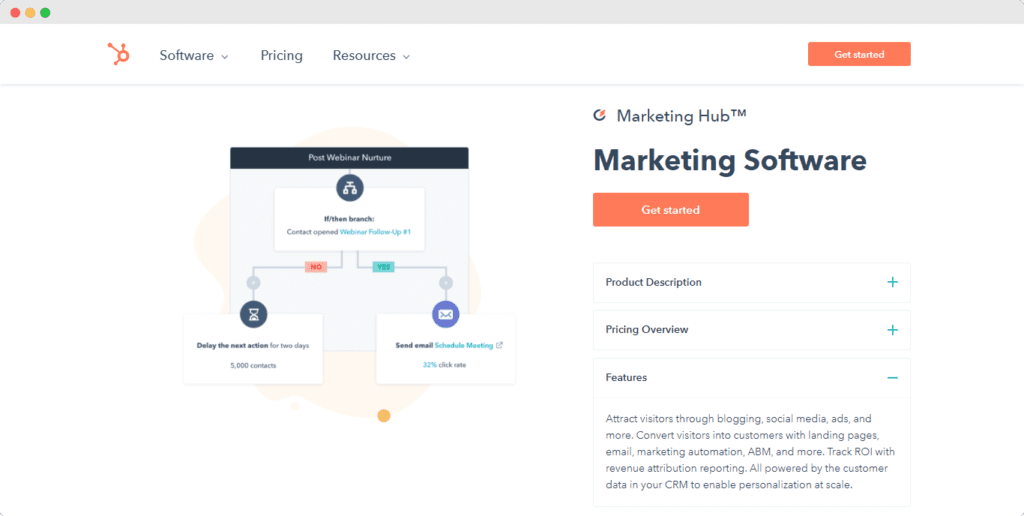
Better known for being an all-in-one CRM platform, HubSpot allows you to track your leads touchpoints across marketing, sales, customer service, operations, and more.
This feature is accessible to enterprise users, and packages start at £2,624 per month.
“The most important digital tool today is Google Analytics. Businesses can track their performance across channels and understand which sources bring the most traffic to the website,” says Paige Arnof-Fenn, Founder and CEO of Mavens & Moguls.

Google Analytics offers a wealth of information about how users find and convert on your website. It allows you to track conversions and break them down by different dimensions, such as traffic source, landing page and location.
Dan Potter, told us that he uses Google Analytics to help analyse shopper intentions, track leads, and optimise their website performance.
“When it comes to tracking leads, we select Goals from the Admin section in Google analytics. After creating our goal, it will show up in reports. Next, we decide which goal we’re trying to obtain. For example, margin or ROI are some good ways to measure our marketing success,” explained Dan.
What makes Google Analytics great is that it’s free and easy to integrate with other data sources.
For example, using Ruler, we’re able to connect revenue stored in our CRM with marketing source data in Google Analytics.
Related: How to integrate CRM data with Google Analytics for closed-loop reporting
With this integration, we’re able to report and view revenue data throughout the Google Analytics reporting suite for web forms, phone calls, live chat enquiries and more.
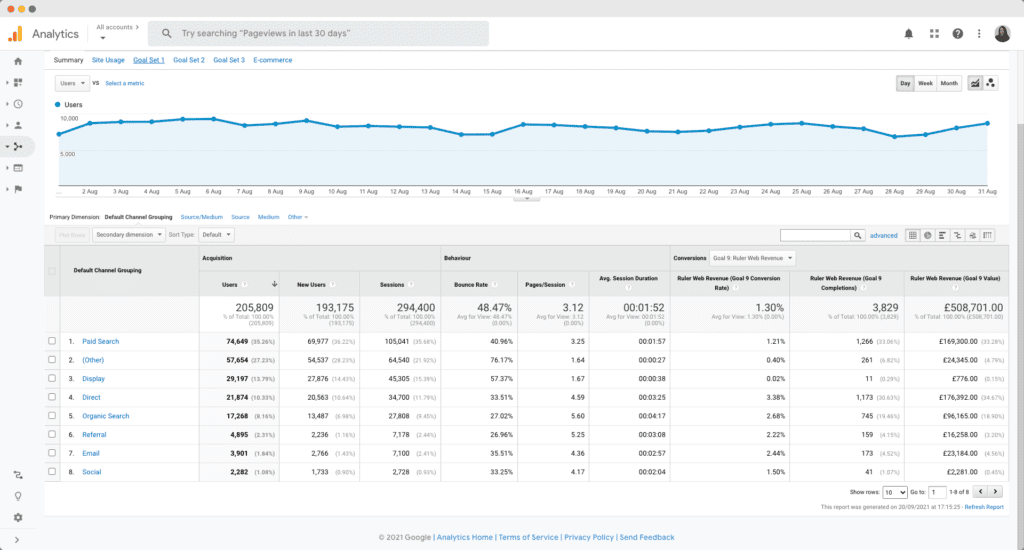
For Gregory Birch, Senior SEO Specialist at Store Space, he integrates Google Analytics and their in-house CMS platform, Storage 360, to gain better visibility of their lead sources.
“We record Events in Google Analytics when a potential customer fills out our reservation form, uses our Live Chat function, or places a call. Storage 360 records source attribution for these events as well. Therefore, we’re able to look at both of these sources and paint a clear picture of our leads,” Gregory added.
Built for high-growth sales teams, MoData is a fully automated sales analytics and revenue reporting platform that comes complete with lead source tracking functionality.
“We use MoData to analyse sales, revenue, and lead source tracking. Their pipeline reporting features are top-notch and allow the sales team to compare sources to ensure that our marketing strategies effectively optimize our pipeline. They have pre-built sales reports that are a massive time saver, and the system sends automated alerts to the right employees regularly,” says Brian Dechesare, Founder at Breaking Into Wall Street.
🚀 Pro Tip
You can now go beyond call conversions and identify which marketing sources drive the most offline revenue and long-term value.
Download the offline conversion tracking eBook
Despite the growth of modern technology, many leads are still embracing traditional forms of communication, such as face-to-face conversations and telephone calls, to connect with brands and make important purchasing decisions.
“When considering options, searching for detailed information, or seeking assistance, many leads prefer to pick up the phone and speak with someone,” says Chana Charach, CFO at income.ca.
If you promote your business online and generate a lot of leads over the phone, then you should be using call tracking.
“Call tracking technology enables you to place a unique tracking phone number in every marketing source, such as your PPC ads and offline tactics, giving you the capacity to see where your calls are coming from. Many call tracking technologies record the call so you can reach further insight into your leads,” says Daniel Foley.
Good call tracking technology allows you to connect your non-digital advertising campaigns, such as print or TV adverts, to your CRM and marketing analytics, allowing you to join the dots between your advertising spend and revenue.
While digital advertising is surging, traditional forms of marketing are still effective in acquiring targeted leads and sales.
In fact, Jeff Johnson, Owner and Acquisition Manager at Sample Home Buyers, believes that television advertising remains extremely relevant and is a valuable source of leads.
“When combined with a powerful call-to-action, TV advertising can produce astounding results. There is still a sizable percentage of people who trust the items and services offered on television. As a result, it is essential to identify this consumer base to acquire their trust and convert them into successful leads,” Jeff added.
By integrating call tracking with your TV, radio, and print ads, you can gain a complete picture of how your offline sources work to generate leads and new customers for your business.
✏️ Product Note
Ruler allows you to report on your offline campaigns i.e. TV, radio, and print ads, alongside all of your online activities. You can apply labels to your offline numbers to identify the source and calculate the ROI more effectively.
“One technique I use to track lead source is tagging all campaigns with UTM parameters. Adding campaign-specific Adding campaign-specific UTM parameters to track blog posts and ads make it easy to tell where traffic is coming from,” suggested Kasey Monohan, Marketing at Volvo Cars Cool Springs.
For lead tracking tools or Google Analytics to work effectively, you’ll need to ensure that the traffic coming to your website is tagged correctly with UTM parameters.
Related: How to track links in Google Analytics
This will allow you to identify the exact source of your leads and any other marketing variables such as medium, campaign name and more.
While UTMs are useful for tracking people to your website, they don’t provide much information about who your leads are or what they do afterwards.
Chris Nutbeen, Founder and Owner at Nuttifox, also agrees, “UTMs are useful for tactics like social media, email, and online advertising that have a particular purpose of driving clicks to your site. However, this doesn’t provide information about your contacts.”

That’s why we strongly suggest you use UTMs in conjunction with other lead tracking solutions to get a complete picture of your marketing sources.
“Dedicated promo codes, vanity URLs, and calls to action can be used to link lead source data to sales,” says Hamza Ghayas, Marketing Manager at GSDLovers.
Promo codes are a great way to entice new and existing customers, but they can also be used to track specific campaigns and lead sources.
For example, if a user comes to your website after watching an advertisement on the TV and uses a promo code when making a purchase, you’ll find it easy to attribute that lead back to the source.
Will Ward, CEO at Translation Equipment HQ, runs a series of codes across a variety of platforms. “Depending on the code they have used to register, we can track where the lead is coming from. Generally, they come through our successful social media campaigns,” added Will.
“We usually have a short question during registration which simply asks the prospective customer where they have come from. We find this direct approach gets quite good results without the trouble of running separate platform campaigns across multiple sources,” says Amy Troutman, Head of Business Operations at Resourceful Compliance.

Asking customers how they discovered your products and services can help you to track and assess which marketing sources are most effective for your business.
“We are straightforward and ask the question because I believe it’s valuable information and we’ve never had anyone be bothered by us asking. We either ask in person, or we ask in some sort of messaging that goes out to clients,” says Sean
While it’s good to get feedback from customers, you mustn’t take this information for granted.
🚀 Pro Tip
We found that 72% of leads that self-reported attribution were inaccurate or missing. That’s nearly three-quarters of all of our leads. You can learn more about this study below.
Why asking how ‘how did you hear about us?’ isn’t enough
Purchasing decisions are getting longer, and users will often forget specific interactions throughout the customer journey.
Related: Guide to customer journey stages and how to track them
For example, let’s say you see a Facebook advertisement from a local dealership for a new car. You click on the ad, take a look around the website and leave.
Six months later, you find the car on Google and book a test drive with the same dealership. You meet up with the sales rep, and you’re asked how you first heard about the dealership.
Chances are you’ve forgotten about the interaction you had with Facebook, and you tell the sales rep that you found the dealership using Google.
But, we know that’s not true.
If the car dealership were to use this method to optimise their marketing budgets, they may stop dedicating as much time to Facebook.
Feedback would suggest that it’s not working, when in fact, it is.
That’s why lead tracking and marketing attribution tools are essential. They can keep a record of your interactions and ensure the proper allocation of credit and revenue.
By now, you should know the importance of lead tracking and have collected plenty of tips to help get you started. By putting in place the following best practices, you can ensure that you’re getting the most value out of your lead source tracking.
While using multiple marketing channels may seem like the most effective way to reach a bigger audience, it’s not always the right approach.
When you advertise your business through too many marketing channels, you end up spreading yourself too thin and lose sight of what’s important.
“We use a combination of tracking our blog posts, guest posts for web sources, and social media lead tracking. The biggest thing about tracking lead sources is the ultimate need to avoid source clutter. To avoid confusion and over-clustering, one shouldn’t track too many sources,” says Alina Clark, Co-Founder & Marketing Director at CocoDoc.

Rather than advertise everywhere, you’re much better off focusing your efforts on a handful of platforms that are most likely to drive business growth.
By honing in on your highest value channels and creating a consistent flow of content, you can more effectively connect with your target audience and ensure the continued health of your bottom line.
But, with so many ways to promote your business online, how do you decide which channels are worth your time?
Methods such as closed-loop marketing allow you to tie closed/won revenue back to individual marketing campaigns and determine which specific activities are most effective in driving sales.
Such connectivity allows you to double down on your most profitable initiatives to increase qualified leads and marketing-generated revenue.
🚀 Pro Tip
Want to learn more about closed-loop marketing and how it can improve the quality of your sales and marketing reports? Download our guide on closed-loop marketing attribution, the easiest way to attribute revenue, and start demonstrating the value of your efforts.
“The use of customer relationship management software helps me with tracking lead sources. With a CRM, I can understand the best offers that leads are more inclined to respond to, their movement along the pipeline, and even pinpoint any trends within my sales process.” says Eden Cheng, Marketing Director at WeInvoice.
Tracking lead source data in your CRM allows you to keep on top of leads and continually assess which sources are generating the best results for your business.
Related: How to send lead source to your CRM with Ruler
You can see how leads are converting into customers and empower teams to focus on the marketing and sales tactics that produce the highest ROI.
For Logan Mallory, Marketing VP at Motivosity, they integrate Google Analytics with their CRM to gain a clear picture of their marketing lead sources.
Related: How to integrate CRM data with Google Analytics for closed-loop reporting
“We capture conversion data such as requests for demos or signups and any purchases in our CRM. Our analytics tools integrate with our CRM so we can link conversion data to marketing lead sources in Google Analytics and vice versa,” added Logan.
“We use Salesforce, to track marketing lead sources. We make sure that the lead source doesn’t change even if the same lead responds to a different campaign,” says Ruben Gamez, Founder and CEO at Docsketch.
Related: How to automatically add marketing lead sources in Salesforce
Steve Scott, CTO at Spreadsheet Planet, also follows the same principle, “the lead source merely identifies the source. Even if the lead responds to a new campaign, the lead source should never change.”

Taking into account that customer journeys span across 20+ and 500+ touchpoints, chances are your leads are going to interact with your marketing channels and campaigns more than once.
Related: Complete guide to tracking touchpoints
Instead of changing or updating your lead source, consider adding an “original lead source field” to your CRM and then allow it to capture any subsequent interactions using custom fields.
Tools like Ruler take out the legwork by automatically updating existing leads in your CRM with marketing source variables when a conversion takes place.
For example, let’s say Jamal makes an organic search in Google and lands on your website. He takes a look around and downloads one of your eBooks.
A week later, Jamal clicks on a retargeting ad on Facebook and fills out a book a demo form. On the initial visit, Ruler would record Jamal’s interaction in your CRM as a new lead and would enrich it with marketing source variables.
Any following interactions and Ruler would update the existing record on Jamal with additional marketing and conversion data.
“We’ve plugged various channels that drive leads into our CRM, such as Google Ads, landing pages, and organic traffic. We drill down into spend/effort/action versus yield to identify the best performers in terms of ROI and so on,” says Polly, Senior Marketing Manager at English Blinds.
Technology, production techniques and customer demands are constantly changing and evolving. In order to survive and grow, marketers must continually reevaluate the significance of their marketing channels.
Don’t forget, Myspace was once the largest social networking site in the world. But one day, without even knowing it, you went on there for the last time.
Jason Mitchell, CTO at Smart Billions, suggests “taking a sample of closed opportunities at the end of each quarter to verify relevant lead sources.” That way, you can gain a holistic view of what’s working and uncover key insights to convert more leads into opportunities as you move into the new quarter.
Related: Track sales opportunities and prove your impact on ROI
It’s essential to understand the value of each lead source.
The more you know about your leads and how they will move through the sales cycle, the better your chances at generating more revenue and growth for your company.
Don’t forget, Ruler makes the process of lead source tracking easy by combining your revenue and marketing data. Such connectivity allows you to effectively track which marketing sources are driving the most qualified leads and revenue.
Want to learn more about Ruler? Our team would love to chat with you. Book a demo and see the benefits of lead source tracking for yourself.
